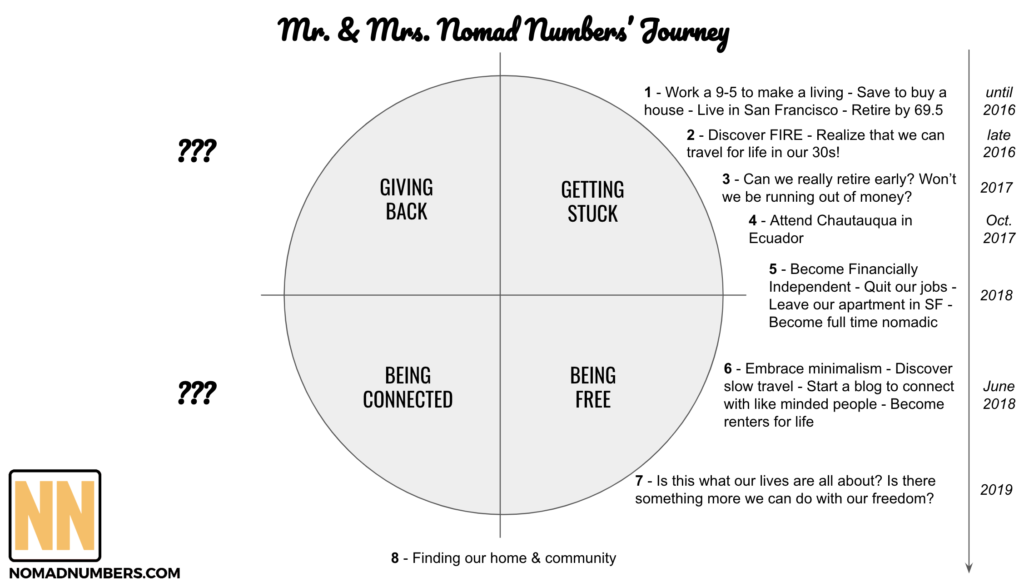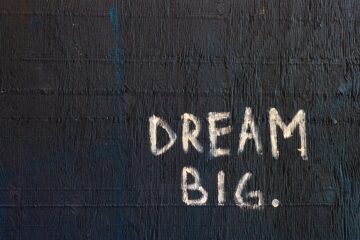This is a pretty dense lifestyle article, which is a follow up on our origin story. If you aren’t into lifestyle design, feel free to skip and check out one of our destination report instead!
One of the benefit of slow travel for me can be quantified by the number books I’ve been able to read since we embarked on our nomadic journey. I recently discovered Sapiens: A Brief History of Humankind, a thought-provoking odyssey through human history. While I won’t go too much into the book in this post, the author go in length to explains how humans see the world is mostly defined by the stories we create for ourselves. This reminded me about the Hero’s Journey that Vicki Robin (author of New York Times Bestseller Your Money or Your Life) introduced to us when we met her at the Chautauqua Retreat in Ecuador (back in 2017). It is a wonderful self transformation template that can be used by anyone looking to design their best life so I felt like it was worth sharing. Are you ready to follow your bliss?
(author of New York Times Bestseller Your Money or Your Life) introduced to us when we met her at the Chautauqua Retreat in Ecuador (back in 2017). It is a wonderful self transformation template that can be used by anyone looking to design their best life so I felt like it was worth sharing. Are you ready to follow your bliss?
This page may contain affiliate links.
Please read our disclaimer page for more info.
What is the hero’s journey?
“The cave you fear to enter holds the treasure you seek”
Joseph Campbell
The Hero’s Journey came from Joseph Campbell, a widely respected philosopher who wrote The Hero with a Thousand Faces. The book highlights the characteristics of a successful story that Campbell describes as a 12 steps process. The process start/finish from the ordinary world (the known world) and go through a growth/change that is also called the special world (or the unknown). This pattern of descent/return, diving/emerging is what makes any stories resonate. Our society longevity also depends on people journeying into the unknown and returning with some ideas, emerging with something new or forgotten.
Note: While this process is widely use among story tellers, it can also apply on someone’s personal life journey as we will explain in this section.
Let’s go over each step to explain what they are, how they affect the hero’s journey and show any parallels they have with our lives. To start, I’ve put each step on the following diagram, starting from step 1 and going clockwise.

Step 1 – Ordinary World
This is where the story start. The heroes follow the status quo and is a lesser version of himself. In our life this translates to where our lives start. We usually follow what our family/friends/society told us to do. This usually leads us to live a life which isn’t our own.
Step 2 – Call to adventure
This is where destiny has summoned the hero. It’s an opportunity to embark in a new quest that will change everything the hero knows about. In our life this translate to chasing our dreams.
Step 3- Refusal of the call
The hero will usually refuse to take the adventure at first due to fear, insecurity or uncertainty. In our life this translates to avoiding our own issues in our unconscious mind. It is the opportunities we aren’t taking because we think they are too risky.
Step 4- Meeting the Mentor
The hero meets a mentor that give us insights, wisdom and guidance that will help them on their journey. In our life this translates to the people we are inspired by that have an impact on our lives.
Step 5 – Crossing the threshold
This is where the hero goes from the ordinary world (know) to the special world (unknown). This is where the adventure or self discovery begins and it is a place of no return. In our life this translates to taking action that will change your life forever and from which there is no return.
Step 6 – Tests, Allies and Enemies
The hero learns the rules of the new world, adapts to its new environment. The hero is being tested to be prepared for the ordeals that lie ahead.
Step 7 – The approach (or the descent)
This can be a location where there is a danger or an inner conflict the hero has to face. In many myths the hero has to descent to hell to retrieve a loved one or into a cave to battle a dragon. In our life this translates to a metaphor for life. This is when you break through the other side of what you fear most that bears the biggest reward and growth.
Step 8 – The ordeal
This is usually the biggest challenge a hero must face. Only through the form of death can the hero be reborn experiencing a metaphorical resurrection that will grant him greater power in order to fulfill his destiny. This is the high point of the hero story where everything he holds dear is put on the line. In our life this translates to resolving the call to adventure.
Step 9 – The Rewards
After triumphing the ordeal, the hero receives a reward that is either a physical object, knowledge or even love. In our life this translates to settling a conflict with a family member or healing a trauma that gives you a better understanding of yourself, allowing you to fill a much happier and fulfilled life.
Step 10 – The Road Back
The hero realized that he needs to return to the ordinary world and that the special world must be left behind. There is still danger, temptation and test ahead. If the hero hasn’t resolve the issue with the conquered villain it will come after it with a vengeance. In our life this translates to getting pulled back from a bad situation (lifestyle inflation, bad habits, addition and dark past coming back at us).
Step 11 – Resurrection
Death and darkness are encountered one more time before being conquered for good. Danger is usually at the peak of the story and the threat is to the entire world, not just the hero. The stakes are at their very highest. The heroes use all the lessons learn on the journey and he is transform into a new being with new insights. In our life this translates to extracting the wisdom we gain over the year and sharing it. It usually represents a critical point in our life.
Step 12 – Return with Elixir
Once the transformation is complete the hero returns to the ordinary world with an elixir. Without getting the elixir, the hero is doomed to repeat his adventure until the lesson is learned. In our life this translate to a metaphor for growth, love, wisdom, freedom or knowledge that we can use to help anyone in the world.
How does the hero’s journey apply to us?
Let’s now take this template and apply us to our lives to give you a concrete example. For context, please make sure to read our origin story.
Here is what our journey looks like:

Let’s go into each step one by one and explain them in more depth.
Step 1 – Ordinary World
In our current society (as we know it today) I was born and raised in France where I got a good education (which was luckily free) and then move to San Francisco when I found a job that helped me trade my time for some money. In my 30s I met Mrs. Nomad Numbers (NN). Before we met we both thought to save a lot in order to buy a 1+M$ house (the entry level price tag in the area) in order to live in the San Francisco Bay area until we retire at the old ripe age of 69.5 years old.
Step 2 – Call to adventure
Earlier in our dating life, Mrs NN and I were dreaming about traveling the world for a year. During the planning process, we stumbled upon stories of people that were traveling perpetually and soon enough we discovered Financial Independence (FI). FI was our call to action that would let us live our dream of travel.
Step 3- Refusal of the call
FI was challenging some of the core concepts we grew up when it comes to retirement. Such as that retirement is not a function of how long you work but rather a function of how much you save. And in order to become financially independent you “just” need to save about 25x the money you plan to spend annually.
For a while we were sceptic about the idea of becoming Financially Free since nobody around us was taking this path. Can this concept that mostly popular bloggers/writers are spreading be a scam? And what guarantees that we won’t be running out of money once we get there?
At the same time we were wondering if we could even travel slowly without being safe, bored or lost (both physically and emotionally).
Step 4- Meeting the Mentor(s)
In early 2017, by luck we stumbled upon the Chautauqua retreat in Ecuador that was taking place in the fall of 2017 and booked the last spot. There, we met a few financial bloggers that we started to follow (including Pete from Mr Money Mustache, Jim Collins, Kristy and Bryce (from Millennial-Revolutions) & Vicky Robbin (Your Money or Your Life). There was also a dozen couples like us that were either pursuing Financial Independence or had already reach FI. Through a week long seminar (nested in the beautiful & remote location) we had opportunity to spend 1:1 with the speakers of our choice and also had plenty of time to share our concern/questions with the people that attended the retreat. This provided us with the confirmation that Financial Independence was something we could achieve and pursue and that a slow/perpetual travel lifestyle can be extremely fulfilling.
Step 5 – Crossing the threshold
The threshold for us was four folds.
- Getting to Financial Independence
- Quitting our jobs
- Selling most of our possessions
- Becoming full time nomadic.
We check these four items in the summer of 2018. From there we definitely felt like we were crossing a point of no return (at least for the next 1-2 years).
Step 6 – Tests, Allies and Enemies
As we started to travel, we had to adjust to our new environment and had to learn new rules to adapt. For instance, we became aspiring minimalist, we reduced our belongings to what could fit in our carry-on, we signed up for an online mailbox to still have access to our physical mail anywhere, we leveraged travel rewards to fly the world for free, we developed our own AirBnB tips to significantly save on accommodation and last but not least we embraced slow travel.
Step 7 – The approach (or the descent)
After traveling for almost a year, with mostly no W-2 income (I said mostly since Mrs. NN kept working for a few more months after I quit), we have now a strong confirmation that Financial Independence & Slow Travel aren’t a myth. We did however had a mini identity crisis. Is slow travel really want we want our new life to be? Now that we don’t have to work for money and have all of the time on our hands, what should life be about? It’s a pretty deep questions that we are still exploring the answer(s).
Step 8 – The ordeal
This is were we believe we are today. This step is still a work in progress for us and represents our next important life transition after reaching FI.
We think that we will keep slow traveling the world extensively for a few years (5-10 years?). During this time we expect to have visited enough cities/places in the world that we would find our favorite(s) place(s) that we could call home and settle down for part of the year. Travel would still remains center to our lives but we can start (re-)building a local community. Through our journey, we expect to meet new people, discover new experiences that would likely encourage us to dedicate some of our time for a good cause.
One more thing…
We went one step further by splitting the circle into four quadrants. (again big thank you to Vicki Robin who presented these concept of quadrants to us during her talk at the Chautauqua).
- We named the first quadrant (top-right) “GETTING STUCK”.
This was a time where our believes were different that the one what have today. It was a time where we considered perpetual travel being a luxury for either the wealthy or the ones that reached their retirement at 69.5 years old. It was a time when we felt that status and consumerism were the way to do well in society. It was a time when we knew very little about personal finance. You can also rename this quadrant: “Inside the Matrix” or “The Rat Race”. - We named the second quadrant (bottom right): “BEING FREE”.
For us this is all about reaching our own freedom from the society we grew up with. It was about really doing what matter the most to us, not what people wanted us to do. Once we overcome our fears (steps 6 & 7) we reach a pure state of bliss and joy. It is a place when we can now have to space to truly focus on ourselves. We are still here at that stage and we might stay here for a few more years. - We named the third quadrant (bottom left): “BEING CONNECTED”.
This is all about connecting back with the world as a whole. Finding a purpose in life that goes beyond our own fulfillment. We are just starting the scratch the surface on this. - We named the forth quadrant (top left): “GIVING BACK”.
We hope to get there but we don’t know when. This will be when we get back to our current society with everything we’ve learn and bring back the Elixir that will help make the world a better place. 🙂
Which bring us to this updated diagram of our own journey:

What about you?
Thanks for reading that far. The Hero’s Journey is a remarkable template that can be used beyond it’s primary use of story telling. It has been a great GPS/compass that helped us find where we were in our own journey. It has also become a powerful guiding light that provides us a True North that we still follow today.
We believe that everyone still in the first quadrant of their own journey can truly benefit for it. If you are at currently trying to figure out what your ideal life can looks like, this is a great tool that we hope you will consider adding to your your arsenal!
Important notes:
- The Hero’s Journey isn’t a linear path that you reach once and finish forever. It is a cyclic journey of personal transformation where you are constantly faced with challenges and resistances that help you grow constantly and gain wisdom. It isn’t easy as you need to challenge yourself constantly and it all starts with accepting that call for adventure.
- This isn’t about Slow Travel or Financial Independence. I used these for the purpose of illustrating the template. You can (and probably should) think about your own calling(s).
To close, I will let you with this quote from the man behind the Hero’s Journey:
“Follow your bliss and the universe will open doors for you where there were only walls”
Joseph Campbell
What do you think about this template? Where are you on your journey? Have you already identified your calling and are getting ready to cross the threshold? Maybe you are already much further along your own journey? Please let us know by leaving a comment in the comment section below!




3 Comments
Life Outside The Maze · May 28, 2019 at 11:56 pm
I have long been a fan of Joseph Campbell and the hero’s journey ever since watching Willow and Star Wars as a kid and then finding out that George Lucas based his story arcs off of Campbell and mythology almost exactly. I love how you mapped this to your current adventure and it is exciting because you are currently in the midst of “the ordeal.” Will it be kids and family, will it be a cause that pulls you in from all of your exploring, or will it be ______? The not knowing for sure is part of the adventure for you the heroes I suppose. My lady and I did some slow travel around the world before we had kids and it is fun to watch your journey as well Nomad Numbers. I also recently did a similar post on designing your life: https://lifeoutsidethemaze.com/design-your-life-with-design-thinking/ and I can see that we are both fans of thoughtful diagrams 🙂 I am enjoying reading of your journey and sharing the FI one with you as well.
Mr. Nomad Numbers · May 29, 2019 at 2:21 am
I would say that no knowing what the future hold for us yet is part of our destiny and something we should feel comfortable to accept. Unfortunately I don’t think the reveal will be as good as the one in the movies though.
Great job on your review of the “Designing your Life” book. It is a well done review (with some solid diagrams too!). I left you a review with my personal take on it. I love this book so much that I have been recommending it to people around me as well as people reading our blog (https://nomadnumbers.com/books).
As for the rest of your comment, should we work on a Ven diagram of our lives and see how much they overlap? 🙂
[Interview #006] Semi-nomadic lifestyle through minimalism and house sitting - Nomad Numbers · January 19, 2020 at 7:39 am
[…] basis to help you better understand [what] is right for you” – Ultimately this boil down to defining your purpose in life. It is so easy to get stuck in the hamster wheel of modern consumerism society. A place where we […]